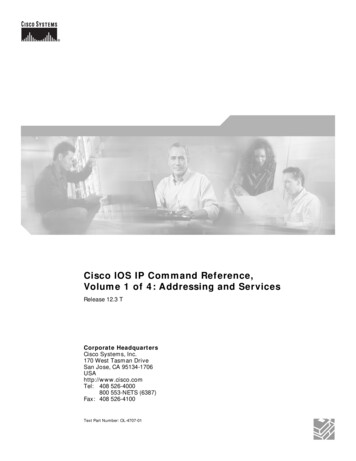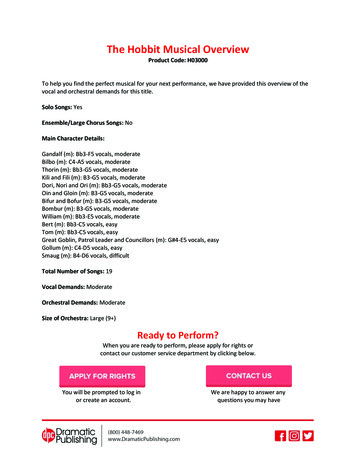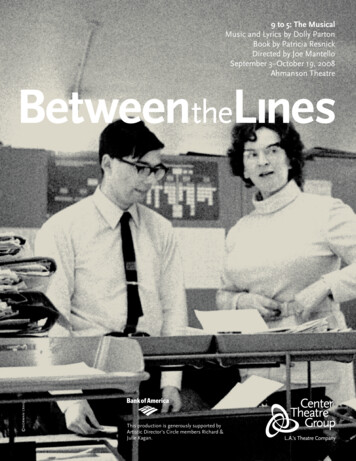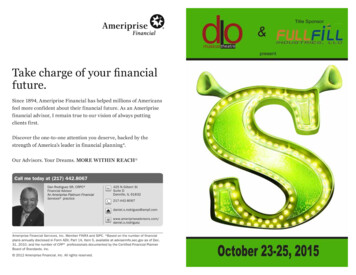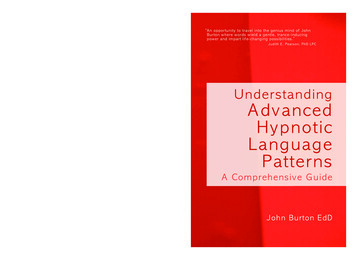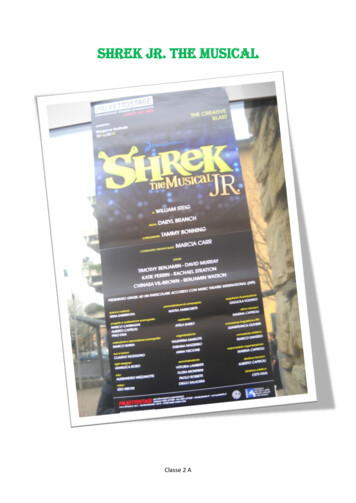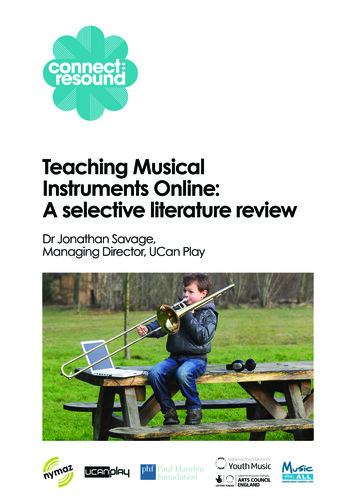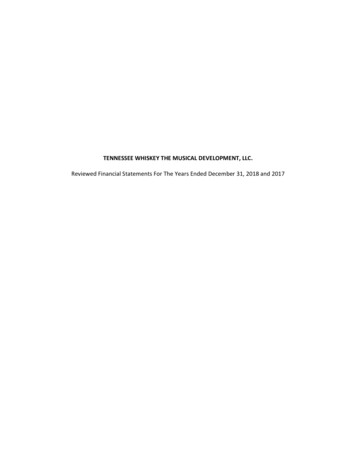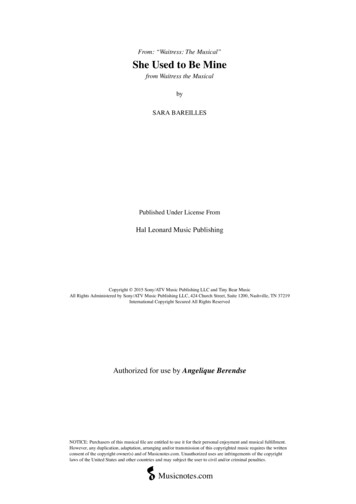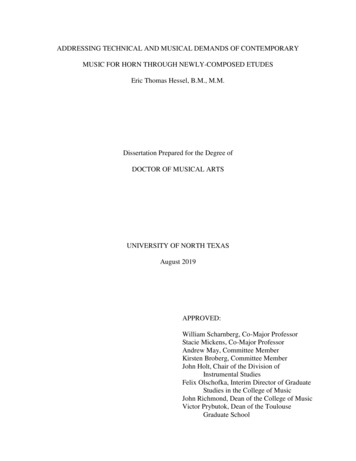
Transcription
ADDRESSING TECHNICAL AND MUSICAL DEMANDS OF CONTEMPORARYMUSIC FOR HORN THROUGH NEWLY-COMPOSED ETUDESEric Thomas Hessel, B.M., M.M.Dissertation Prepared for the Degree ofDOCTOR OF MUSICAL ARTSUNIVERSITY OF NORTH TEXASAugust 2019APPROVED:William Scharnberg, Co-Major ProfessorStacie Mickens, Co-Major ProfessorAndrew May, Committee MemberKirsten Broberg, Committee MemberJohn Holt, Chair of the Division ofInstrumental StudiesFelix Olschofka, Interim Director of GraduateStudies in the College of MusicJohn Richmond, Dean of the College of MusicVictor Prybutok, Dean of the ToulouseGraduate School
Hessel, Eric Thomas. Addressing Technical and Musical Demands of ContemporaryMusic for Horn through Newly-Composed Etudes. Doctor of Musical Arts (Performance),August 2019, 116 pp., 66 figures, 1 appendix, bibliography, 77 titles.Contemporary music for horn often requires techniques and musical or notationalconsiderations that are unconventional with respect to the standard pedagogy of the instrument.As such, these considerations often represent a level of challenge to which the average—intermediate to advanced—hornist is unprepared to approach or altogether unfamiliar. The mostprominent of these demands arising in the last few decades of the twentieth century throughtoday include microtonality (such as extended just intonation and quarter tones), extendedtechniques in combination or juxtaposition (such as multiphonics and right hand technique),rhythmic complexity (including metric modulation, non-dyadic meters, additive rhythms, andnested tuplets), and unconventional notations (graphic, spatial, and other temporal notations).This document first surveys the challenges of the repertoire in question, which includes works byGyörgy Ligeti, Thea Musgrave, Milton Babbitt, Brian Ferneyhough, Iannis Xenakis, HeinzHolliger, and Douglas Hill, among others. After considering the merits and limitations ofexisting pedagogical materials that work towards these ends, the document then underlines astrategic pedagogical goal for understanding and approaching unconventional contemporaryrepertoire through newly-composed etudes. This document is written in conjunction with andjustification for the author’s 24 Unconventional Etudes for Horn, and includes examplestherefrom.
Copyright 2019byEric Thomas Hesselii
ACKNOWLEDGEMENTSMy sincerest appreciation goes to my co-major professors: Dr. William Scharnberg, forhis tutelage, and extensive pedagogical and editorial experience; and Dr. Stacie Mickens, for hernew perspectives and valuable insights at a pivotal point in the process. I would also like to thankmy related field professor in composition, Dr. Andrew May, for challenging and developing mycompositional style, and my committee member Dr. Kirsten Broberg for her further insights intocomposition and horn. I am also very grateful to my friends and family, especially my wife MaiTadokoro Hessel, for encouraging me along every step of the process.iii
TABLE OF CONTENTSPageACKNOWLEDGEMENTS . iiiLIST OF FIGURES . vCHAPTER 1. INTRODUCTION . 11.1Significance and State of Research . 21.2Method . 5CHAPTER 2. THE STATE OF REPERTOIRE . 92.1Microtonality. 92.2Other Extended Techniques . 252.3Rhythm . 302.4Notation. 36CHAPTER 3. THE PEDAGOGICAL GAP . 393.1Exploring the Natural Horn . 403.2Harmony . 463.3Extended Techniques . 553.4Rhythm . 603.5Graphic Notation . 64CHAPTER 4. COMPOSITION OF NEW ETUDES . 674.1Etudes for the Crooked Horn . 694.2Etudes in Extended Just Intonation . 734.3Etudes in Approximated Quarter Tones . 764.4Etudes Combining Extended Techniques . 794.5Etudes Exploring Advanced Rhythms . 834.6Etudes in Unconventional Notations . 88CHAPTER 5. CONCLUSION. 95APPENDIX: SELECTIONS FROM 24 UNCONVENTIAL ETUDES FOR HORN. 98BIBLIOGRAPHY . 113iv
LIST OF FIGURESPageFigure 1.1: Basic overtone series on C2 to the sixteenth partial, with intonation deviation. . 7Figure 1.2: Double horn fingerings related to fundamental harmonic series in concert and writtenpitch. 7Figure 2.1: Benjamin Britten, “Prologue” from Serenade for Tenor, Horn, and Strings . 11Figure 2.2: György Ligeti, “Vivacissimo molto ritmico” from Horn Trio, mm. 54-65. . 12Figure 2.3: György Ligeti, “Signal, Tanz, Choral” from Hamburgisches Konzert, mm. 9-15. . 13Figure 2.4: Jörg Widmann, Air für Horn Solo, systems 2-3. . 14Figure 2.5: Patrick Kavanaugh, Debussy Variations No. 11, systems 6-8. . 17Figure 2.6: Thea Musgrave, Horn Concerto, rehearsal 75. . 19Figure 2.7: Thea Musgrave, The Golden Echo (I), system 22. . 19Figure 2.8: Ezra Sims, Tune and Variations, preliminary exercises vi-vii. . 20Figure 2.9: Douglas Hill, “Lost and Found” from Jazz Set, mm. 16-25. . 21Figure 2.10: Robin Hayward, Handwork, mm. 1-4. . 23Figure 2.11: Andrew Perkins, 19-tone equal tempered fingerings. . 24Figure 2.12: Heinz Holliger, Cynddaredd—Brenddwyd, systems 24-27. 27Figure 2.13: George Crumb, trans. Robert Patterson, An Idyll for the Misbegotten, system 4. . 29Figure 2.14: Milton Babbitt, Around the Horn, mm. 8-21. . 32Figure 2.15: Brian Ferneyhough, Carceri d’Invenzione I, mm. 84-86. . 33Figure 2.16: Iannis Xenakis, Thalleïn , mm. 144-146. . 34Figure 2.17: I. Mitsuoka, Pachyderms, systems 5-6. . 37Figure 2.18: Pachyderms, systems 9-10. . 38Figure 3.1: Phillip Farkas, Legato Warm-Up Exercise 1. 41Figure 3.2: Phillip Farkas, Slur Exercise. . 41v
Figure 3.3: Bruce Atwell, natural horn exercises, Natural Horn/Valved Horn Technical Etudes,mm. 244-270. . 43Figure 3.4: Bruce Atwell, valved horn exercises, Natural Horn/Valved Horn Technical Etudes,mm. 295-312. . 43Figure 3.5: Verne Reynolds, No. 11 (Allegro Moderato) from 48 Etudes for French Horn, mm.1-4. . 48Figure 3.6: Douglas Hill, “Quarter Tone Fingering Chart for the Full Double Horn” . 50Figure 3.7: Douglas Hill, “Optional Quarter Tone Fingering Chart” . 50Figure 3.8: Timothy Thompson, Etude 5.1, “Quarter-tones employing pitch bend and out of tuneovertones combined.” . 51Figure 3.9: Timothy Thompson, Etude 5.2, “Quarter-tones employing retuning.” . 51Figure 3.10: Ricardo Matosinhos, No. 4 “Quarter Tone Blues” from 12 Jazzy Etudes, mm. 1-7.52Figure 3.11: Ricardo Matosinhos, No. 11 “Dance of the Overtones” from 12 Jazzy Etudes, mm.9-12. . 53Figure 3.12: Scott Whitener, Harmonic series on the F horn open and stopped, from A CompleteGuide to Brass. 56Figure 3.13: Francis Orval, “The Functions of the Six Standard Hand Positions” . 58Figure 3.14: Gunther Schuller, No. 12 (Lento) from Studies for Unaccompanied Horn. . 59Figure 3.15: Michael Mikulka, “Producing your first multiphonics” from A Practical Method forHorn Multiphonics. . 60Figure 3.16: Gunther Schuller, No. 7 (Con moto) from Studies for Unaccompanied Horn. . 62Figure 3.17: Ricardo Matosinhos, No. 2 “Two, Three, Five” from 12 Jazzy Etudes, mm. 1-15. 62Figure 3.18: Jacques François Gallay, No. 24 from 40 Préludes, systems 1-2. . 63Figure 3.19: Verne Reynolds, No. 44 from 48 Etudes for French Horn, systems 1-3. . 64Figure 3.20: Timothy Thompson, Exercise 2.13 “Overtone Glissando” . 65Figure 3.21: Edmond Leloir, No. 5 “Grafico” from Dix études, systems 9-12. . 66Figure 4.1: Eric Hessel, No. 1 (Andante con moto) from 24 Unconventional Etudes for Horn,mm. 1-4. . 71vi
Figure 4.2: Eric Hessel, No. 1 (Andante con moto) from 24 Unconventional Etudes for Horn,mm. 16-18. . 72Figure 4.3: Eric Hessel, No.1 (Andante con moto) from 24 Unconventional Etudes for Horn,mm. 22-25. . 73Figure 4.4: Eric Hessel, No. 5 (Lento misterioso) from 24 Unconventional Etudes for Horn, mm.13-16. . 74Figure 4.5: Eric Hessel, No. 5 (Lento misterioso) from 24 Unconventional Etudes for Horn, mm.25-36. . 74Figure 4.6: Eric Hessel, No. 7 (Vivacissimo molto ritmico) from 24 Unconventional Etudes forHorn, mm. 1-11. . 75Figure 4.7: Eric Hessel, No. 7 (Vivacissimo molto ritmico) from 24 Unconventional Etudes forHorn, mm. 35-48. . 76Figure 4.8: Eric Hessel, No. 10 (Allegro con brio) from 24 Unconventional Etudes for Horn,mm. 1-4. . 78Figure 4.9: Eric Hessel, No. 10 (Allegro con brio) from 24 Unconventional Etudes for Horn,mm. 14-19. . 79Figure 4.10: Eric Hessel, No. 10 (Allegro con brio) from 24 Unconventional Etudes for Horn,mm. 24-29. . 79Figure 4.11: Eric Hessel, No. 12 (Humoresqu
Figure 3.5: Verne Reynolds, No. 11 (Allegro Moderato) from 48 Etudes for French Horn, mm. 1-4. . 48 Figure 3.6: Douglas Hill, “Quarter Tone Fingering Chart for the Full Double Horn” . 50 Figure 3.7: Douglas Hill, “Optional Quarter Tone Fingering Chart” . 50 Figure 3.8: Timothy Thompson, Etude 5.1, “Quarter-tones employing pitch bend and out of tune overtones combined .

